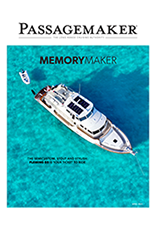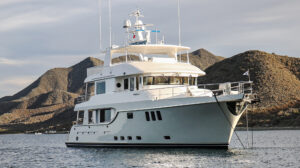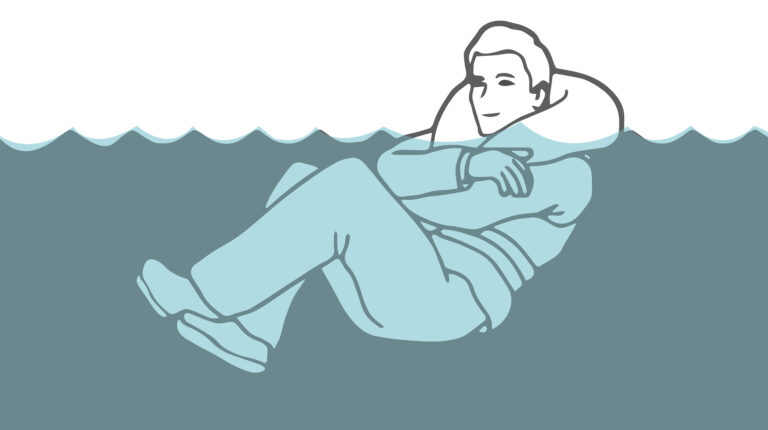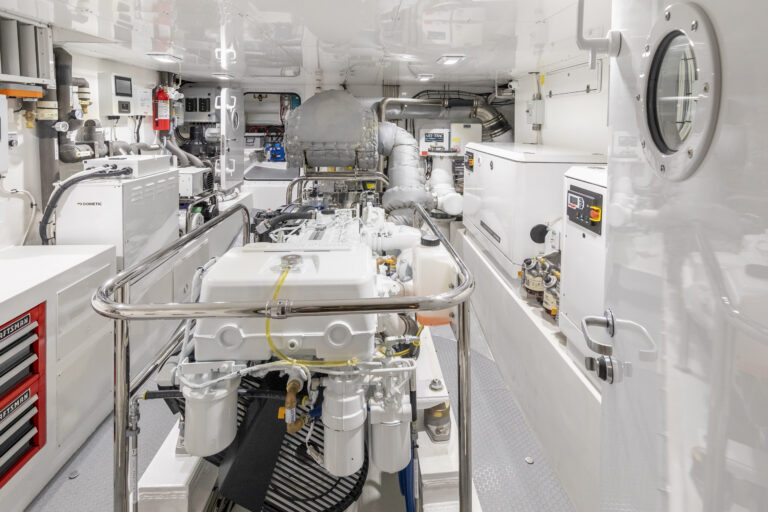Mark and Fiona Rammell spent a lot of years doing what people tend to think of as the right things.
He was a pilot for Air New Zealand for more than three decades, flying the long hauls to Los Angeles. She was a primary-school teacher who went on to specialize in mathematics. They raised four children: three boys and one girl. They also built their own business, managing 14 acres of beautifully manicured gardens that draw about 30,000 visitors each year to see the cherry blossoms and more in New Zealand’s capital city.

But these next 10 years? According to Mark, “We’re going to be selfish.”
He’s 62 years old. She’s 57. All the kids are grown. For the past few years, they’ve had a share in a Salthouse 60 that they’ve enjoyed cruising aboard locally, and Mark has been thinking more and more about his dream of taking a boat around the world. When they lost one of Mark’s good friends to cancer, they felt a sudden urgency about doing what some people might think of as crazy.
“We were busy raising children and paying the mortgage off, but losing my mate taught me that you never know when your time is up,” Mark said in April from on board the couple’s brand-new Nordhavn 51, Awanui NZ. They first spoke to us from the coast of Turkey, near Bodrum, at the start of what they hope will be a five-year global circumnavigation. “We’re learning so much, making really dumb rookie mistakes, but we’re going to get better and better at it.”

Awanui NZ is Hull No. 1 of the N51. It launched in February. The Rammells took delivery, and they set off from Istanbul’s Tuzla province with a Nordhavn representative and a captain to help with the shakedown.
They are, in many ways, ideal owners for the model, which is being built as a production boat to reduce change orders, costs and production time—and to entice owners who don’t want to endure the process of trying to customize a boat of the N51’s size.
That’s the Rammells. Mark had once indulged his circumnavigation dream with a visit to the Nordhavn facility in Dana Point, California, where he got a tour of an N52. “I thought it was the perfect boat,” he says, “but we just couldn’t afford it.” Still, he kept in touch with Nordhavn Owner/Vice President James Leishman, who eventually told them about the yard’s plans for the N51. Mark discussed the idea not just with Fiona, but also with his friend as the cancer took hold.
“Before he passed away, he made me promise that we would do it,” Mark says. “So, we signed up for number three, and about a year later, number one came up, and we jumped on it.”

The N51 was just barely within their financial reach—“it was really tight,” Mark says—but they didn’t even look at other boats. They trusted that the Nordhavn team knew what they were doing after learning that the same yard had already built more than two dozen N41s. They felt like they had input in the process, and Nordhavn delivered the boat with everything right down to glassware and linens.
“It makes the dream of being able to own a Nordhavn more available for people who would otherwise never be able to do it,” Fiona says. “They did it better than I could have or Mark could have done it, for sure.”
The N51 has two en suite staterooms, a day head and a flybridge. The pilothouse is similar to those that Nordhavn builds on long-range cruising boats, and the interior mirrors the N41’s. Standard equipment includes stabilizers, a bow thruster, a davit and twin 160-hp John Deere engines. Garmin electronics also fill the standard spec sheet—with enough features that they’ll even keep a pilot like Mark busy for months.
“The pilothouse is great, but there’s so much to learn,” he says. “When you work for the airlines, the training is unbelievable. You sit in a classroom for a month learning about a particular airplane, and then you get in simulators and practice everything. When you’re doing it yourself, you can’t afford to do that. The only thing you can do is use common sense, be careful and be sensible.”
That’s exactly what they’re doing as they begin their five-year journey. Mark has taken the Coastguard Boatmaster course in New Zealand, and he’s using Awanui NZ to get in his practical hours. Fiona isn’t yet ready for overnight cruising—they’ll have a friend of Mark’s fly in for that, and she’ll travel landside—but she’s keeping an open mind after their first few weeks on board.
Awanui NZ has had a few teething problems, they say, but nothing that has them particularly concerned. Nordhavn had to work out a backpressure issue on the wet-exhaust system, and faulty cylinders on the stabilizers dumped a bunch of hydraulic fluid into the bilge, but the Nordhavn and ABT-Trac teams were on top of it all. Within a couple of months, the engines came loose from their mounts and needed tightening, and the water pump had to be replaced with a larger one. “You’re only allowed to stay for three months, but in a perfect world, we would’ve popped out of Turkey and gone back and stayed closer to Istanbul, where the factory is,” Mark told Passagemaker in June, with the benefit of a couple months’ hindsight. “But having said that, all the people we’ve dealt with in Turkey haven’t hesitated to come over to Athens or get people in Athens to help us on whatever work had to be done.”

The Rammells are also dealing with operator error, which they fully expect to have more of as they get to know the boat’s systems. In just the first couple of months on board, Mark says, the really big lesson they’ve learned is that the sea can deliver unexpected situations, so cruisers need to have a plan for dealing with various scenarios.
As a former pilot, Mark says he feels quite comfortable being prepared for those possibilities. Fiona, on the other hand, is taking a bit longer to adjust to the way life works when you move on board.
“I just think it’s showing how different our personalities are,” Fiona says. “On a day-to-day basis at home, you’re off doing your own thing. On a boat, you’re together 24/7, and things you were aware of become even more heightened. That’s why I can say to Mark that he needs a mate to come on and do some legs of the journey together, so he has somebody to share that sense of adventure.”
Their goal is to be wherever they’re going to stay that night by about lunchtime on the same day. That gives them time to handle any challenges, an opportunity to anchor in the spot that they want, and the ability to beat the breeze that kicks up in the Mediterranean after lunchtime.

Their favorite destination so far has been Greece, where they did warranty work in Athens and had a chance to explore the islands in the Cyclades and Peloponnese archipelagos. From there, they cruised up the Corinth Canal and to the Ionian Sea, left Corfu at the beginning of June, cruised for a few days through Albania and arrived in Montenegro, where they plan to stay for about two months to satisfy the requirements for being from a non-EU country.
All along the way, they are learning more and more about the boat and how to use it. When he’s not looking online for answers to problems they encounter, Mark is reading electronics manuals. “I look at the autopilot, and I think: What if I push a button and it doesn’t disconnect?” he says. “For young people, they just take it and away they go, but as you get older, you get a little bit slower at learning things. We’re going to take our time.”

And, they’re learning about all their favorite spaces on board. The galley, they both say, is perfectly positioned amidships, so the cook can remain part of whatever is happening in the salon. There’s no dishwasher, but they share that chore after every meal. And Fiona says she loves the washer and dryer, which eliminate the need to lug laundry up the dock.
Mark’s favorite space is the covered cockpit. “When we’ve done our day’s work, we can just sit there, have a glass of wine or a beer, and relax,” he says.

The spot was an especially ideal perch when they anchored stern-to at various quays in Greece, he adds.
“You can stand on the back of your boat, nod to the man at the bar, and he’ll bring you a beer at your boat,” Mark says. “You walk to the quay and have a meal. It’s incredibly friendly for boaters. The people are lovely. The food is lovely. And the pricing is very fair.”
Their plan overall is to continue anchoring out as much as possible, which helps to keep cruising costs down. Mark says that at 7 knots, Awanui NZ burns about 2.5 gallons of fuel per hour. That speed also helps a lot with Mark’s confidence at the helm. He says he has no desire to cruise any faster.
“When you’re flying an airplane at 35,000 feet, you’re not going to run into anything. Here, you can run into everything,” he says. “And by jingo, things can happen fast at 7 knots.”
After they resume cruising through the Mediterranean, they plan to check out southern Italy, Sicily and Malta, where they will leave the boat as they return to New Zealand for a bit. They intend to return in October, possibly spend the winter in Spain and France, and then spend summer 2025 cruising in Scotland and the U.K.
Beyond that, in 2026, the plan is to spend the summer crossing the Atlantic Ocean by way of Iceland, Greenland and Newfoundland, followed by a cruise down the East Coast of the United States.

“We’re going to come down past Maine, past New York, and then we’ll do the Intracoastal Waterway down to Florida,” Mark says. “We want to try to get back to New Zealand within about five years, so we’ll probably do Cuba and then head through the Panama Canal, and then Costa Rica and Mexico and the West Coast of the U.S.”
Ultimately, they plan to make their home waters of New Zealand the boat’s regular cruising grounds. “We want to enjoy it with family and friends back home,” Mark says. “We love boating in New Zealand.”
They’re also learning that a lot of people share their dream of cruising the world’s waters. Fiona started a YouTube channel
(@AwanuiNZ) so friends and family could keep track of whatever’s happening on board. She got the idea from their daughter, who would post to Instagram while traveling.
“I got so addicted to her photos every day. It was lovely to see what she was doing, and we could rest assured that she was safe, so I thought I would do the same for the boat,” Fiona says, adding that hundreds of subscribers now follow the channel. “They just want to look in the morning and see what’s going on.”
The Rammells are not trying to become social media stars, they say, adding that they’re just an ordinary couple who feel blessed, and who are happy to share their adventure.
“You can come out and say, ‘I could never do that,’ but it’s taught me that absolutely, if you have a dream, start the process and be determined,” Mark says. “Before you know it, the dream will be a reality.”
Nordhavn 51
LOA: 50ft. 9in. • Beam: 15ft. 8in. • Draft: 4ft. 9in. • Displacement: 71,575 lbs. • Fuel: 1,450 gal. • Water: 300 gal. • Engines: 2x 160-hp John Deere 4045AFM85 M1 • Info: nordhavn.com
This article was originally published in the September 2024 issue.











